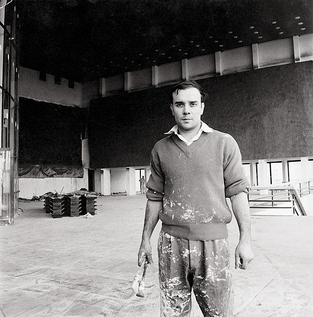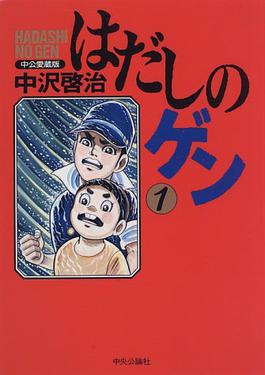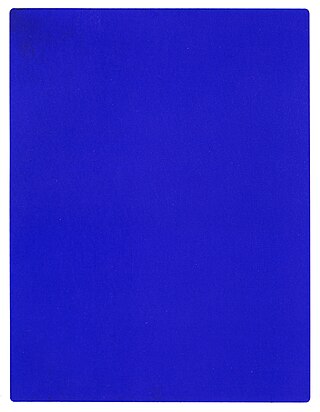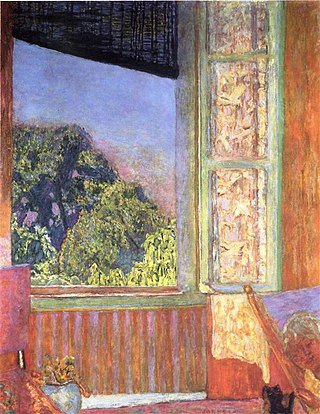Related Research Articles

Yves Klein was a French artist and an important figure in post-war European art. He was a leading member of the French artistic movement of Nouveau réalisme founded in 1960 by art critic Pierre Restany. Klein was a pioneer in the development of performance art, and is seen as an inspiration to and as a forerunner of minimal art, as well as pop art. He is known for the development and use of International Klein Blue.

Monochromatic painting has played a significant role in modern and contemporary Western visual art, originating with the early 20th-century European avant-gardes. Artists have explored the non-representational potential of a single color, investigating shifts in value, diversity of texture, and formal nuances as a means of emotional expression, visual investigation into the inherent properties of painting, as well as a starting point for conceptual works. Ranging from geometric abstraction in a variety of mediums to non-representational gestural painting, monochromatic works continue to be an important influence in contemporary art.

Barefoot Gen is a Japanese historical manga series by Keiji Nakazawa, loosely based on Nakazawa's own experiences as a Hiroshima survivor. The series begins in 1945 in and around Hiroshima, Japan, where the six-year-old boy Gen Nakaoka lives with his family. After Hiroshima is destroyed by atomic bombing, Gen and other survivors are left to deal with the aftermath. It ran in several magazines, including Weekly Shōnen Jump, from 1973 to 1987. It was subsequently adapted into three live action film adaptations directed by Tengo Yamada, which were released between 1976 and 1980. Madhouse released two anime films, one in 1983 and one in 1986. In August 2007, a live action television drama series adaptation aired in Japan on Fuji TV over two nights.

Hibakusha is a word of Japanese origin generally designating the people affected by the atomic bombings of Hiroshima and Nagasaki at the end of World War II.

Body painting is a form of body art where artwork is painted directly onto the human skin. Unlike tattoos and other forms of body art, body painting is temporary, lasting several hours or sometimes up to a few weeks. Body painting that is limited to the face is known as "face painting". Body painting is also referred to as "temporary tattoo". Large scale or full-body painting is more commonly referred to as body painting, while smaller or more detailed work can sometimes be referred to as temporary tattoos.
Jennifer Anne Saville is a contemporary British painter and an original member of the Young British Artists. Saville works and lives in Oxford, England and she is known for her large-scale painted depictions of nude women. Saville has been credited with originating a new and challenging method of painting the female nude and reinventing figure painting for contemporary art. Some paintings are of small dimensions, while other are of much larger scale. Monumental subjects come from pathology textbooks that she has studied that informed her on injury to bruise, burns, and deformity. John Gray commented: "As I see it, Jenny Saville's work expresses a parallel project of reclaiming the body from personality. Saville worked with many models who under went cosmetic surgery to reshape a portion of their body. In doing that, she captures "marks of personality for the flesh" and together embraces how we can be the writers of our own lives."

The Hiroshima Panels are a series of fifteen painted folding panels by the collaborative husband and wife artists Maruki Iri and Maruki Toshi (fr) completed over a span of thirty-two years (1950–1982). The Panels depict the consequences of the atomic bombings of Hiroshima and Nagasaki, as well as other nuclear disasters of the 20th century. Each panel stands 1.8 metres x 7.2 metres.

International Klein Blue (IKB) is a deep blue hue first mixed by the French artist Yves Klein. IKB's visual impact comes from its heavy reliance on ultramarine, as well as Klein's often thick and textured application of paint to canvas.

The Hiroshima Peace Memorial Museum is a museum located in Hiroshima Peace Memorial Park, in central Hiroshima, Japan, dedicated to documenting the atomic bombing of Hiroshima in World War II.

Michael Bidlo is an American conceptual artist who employs painting, sculpture, drawing, performance, and other forms of "social sculpture."

Zone de Sensibilité Picturale Immatérielle is an artist's book and performance by the French artist Yves Klein. The work involved the sale of documentation of ownership of empty space, taking the form of a receipt, in exchange for gold; if the buyer wished, the piece could then be completed in an elaborate ritual in which the buyer would burn the receipt, and Klein would throw half of the gold into the Seine. The ritual would be performed in the presence of an art critic or distinguished dealer, an art museum director and at least two witnesses.
This is a list of cultural products made about the atomic bombings of Hiroshima and Nagasaki. It includes literature, film, music and other art forms.

Nuclear art was an artistic approach developed by some artists and painters, after the bombings of Hiroshima and Nagasaki.

Minimalism describes movements in various forms of art and design, especially visual art and music, where the work is set out to expose the essence, essentials or identity of a subject through eliminating all non-essential forms, features or concepts. As a specific movement in the arts it is identified with developments in post–World War II Western Art, most strongly with American visual arts in the 1960s and early 1970s. Prominent artists associated with this movement include Ad Reinhardt, Nassos Daphnis, Tony Smith, Donald Judd, John McCracken, Agnes Martin, Dan Flavin, Robert Morris, Larry Bell, Anne Truitt, Yves Klein and Frank Stella. Artists themselves have sometimes reacted against the label due to the negative implication of the work being simplistic. Minimalism is often interpreted as a reaction to abstract expressionism and a bridge to postminimal art practices.

Addie Wagenknecht is an American artist and researcher living in New York City and Liechtenstein. Her work deals primarily with pop culture, feminist theory, new media and open source software and hardware. She frequently works in collectives, which have included Nortd Labs, F.A.T. lab, and Deep Lab. She has received fellowships and residencies from Eyebeam, Mozilla, The Studio for Creative Inquiry at Carnegie Mellon University and CERN.

Human Shadow Etched in Stone is an exhibition at the Hiroshima Peace Memorial Museum. It is thought to be the residue of a person who was sitting at the entrance of Hiroshima Branch of Sumitomo Bank when the atomic bomb was dropped over Hiroshima. It is also known as Human Shadow of Death or simply the Blast Shadow.

The Open Window is an oil-on-canvas painting by the French artist Pierre Bonnard, painted in 1921. Depicting a scene in a room, the painting draws the viewer's focus to the natural landscape outside of the window, away from the figures in the bottom right. The work is housed in The Phillips Collection in Washington, D.C..
Rotraut Klein-Moquay, known by the mononym Rotraut, is a German-French visual artist. She is the widow of French artist Yves Klein.

Rudolf Němec was a Czech painter, printmaker, poet and sculptor. He was one of the leading representatives of the New Figuration in Czechoslovakia.
ANT 82, Blue Age Anthropometry is a painting by French artist Yves Klein, created in 1960. Purchased in 1984, this work is part of the collection of the Musée National d'Art Moderne, in Paris.
References
- ↑ Hiroshima, Yves Klein website
- ↑ Camile Maurineau, Yves Klein, Centre Pompidou, 2016 (French)
- ↑ Hannah Weitemeier, Yves Klein, Cologne, Taschen, 2016
- ↑ Hiroshima, Yves Klein website
